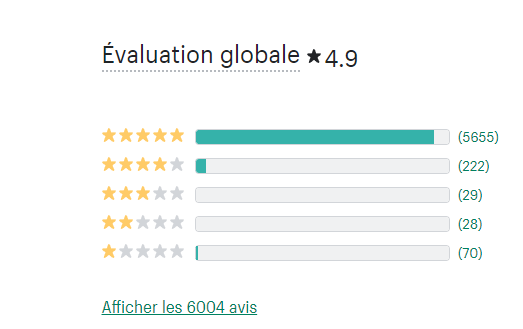Do you like to create beautiful e-commerce pages for your eshop? Having the most beautiful online store is important to show your customers the quality of your products and your brand?
And you're right, even if design and ergonomics are two different things, having a beautiful e-commerce site is a real differentiating factor, especially for branding .
This is why many Shopify users use what are called builder pages , or builder landing pages. In other words, page builders in French.
But by the way, what exactly is a tool like PageFly for and why should we pay attention to this type of application?
What is PageFly used for?

PageFly, like any other page building tool, is a paid Shopify application , between 19 and 99 dollars per month, which will allow you to create pages yourself on your site in “Nocode” mode.
That is to say without the need to learn to code or make Figma models for example. But for the code, we will see that this is not the case in fact.
The indisputable advantage of PageFly is to have understood, long before Shopify, that e-merchants want to create and modify pages as simply as possible while having a beautiful rendering.
Unfortunately for PageFly, Shopify figured this out with the Dawn 2.0 Theme and the entire Online Store v2.
To put it simply, Shopify now embeds almost all (almost) the functionality of a PageFly without the need for the PageFly application.
PageFly has become useless?
PageFly would therefore have become useless? Not quite. Shopify may have caught up with PageFly in some areas, but it is still almost impossible for a merchant to create pages in Shopify as “easily” as in PageFly .

In Shopify, several things are needed for the merchant to be able to create their pages independently:
- A 2.0 theme
- A Shopify agency that will create the necessary blocks (sections, themes and snippets)
- A client who knows a bit about the Shopify customizer
And despite that, it won't be possible to have a really different design from one page to another without technical intervention, so additional Liquid code .
But then PageFly is still useful?
Well yes in the end for certain specific uses, PageFly remains a good way to easily create pages that do not look like the standard templates of your merchant site. However, creating pages on Pagefly is a much more difficult exercise than it looks and contrary to claims of Pagefly itself, it is far from being a Nocode tool.
For example, without any CSS knowledge, it will be almost impossible for you to correctly create a page on both Desktop and mobile without any graphical bugs. And this, even with a simple page composition.

Page Fly is not really a Nocode tool
Because in fact, even if PageFly does not talk about it too much, it is above all a tool intended for people with a minimum of html and css skills, or even design or ergonomics.
Some e-commerce managers have these skills of course, but not everyone is a fan of lines of code.
PageFly is therefore more a “Low Code” tool if we can say so rather than really Nocode. But isn't that the case with the vast majority of Nocode tools in fact?
Note that PageFly is not a development tool, and therefore it is almost not possible to seriously modify the code on the functional side in PageFly.
It is technically possible but there are many limitations. And so we come to PageFly's main problem: the misunderstanding of customers and the intended target.
PageFly causes more problems than anything else
In the end, for an e-commerce agency like ours, and therefore for Shopify maintenance or Shopify technical development, PageFly is more of a problem than a solution.
Many PageFly users are indeed attracted by the “Nocode” and “Drag&Drop” effect of the application. And yes, this vision of managing a template has many advantages and I hope that Shopify will continue to be inspired by that.
However, to finalize the page with a level of ergonomics, graphic quality, integration, “pixel perfect” I would say, it takes a lot of time and skills. You will also most likely have problems with heatmap tools like CrazyEgg if the PageFly code is not clean enough.
However, many merchants contact us at Pikka after having abandoned the creation of the page via PageFly for lack of interesting results.
Pagefly is not a programming language.
But you should know that taking over the code of a PageFly page is almost impossible! Very often our proposal is therefore to start the page from scratch with a nice integration into the Shopify templates.
But it is therefore time and budget. And this can generate misunderstandings when the client thinks it is possible to resume what he has already created with PageFly.
Excluding Pagefly is not a programming language.
It is therefore not possible, and this for any Shopify agency , to build, in code, on top of it, except perhaps to ignore all the concepts of ergonomics, web performance and code maintenance.
PageFly is therefore an interesting solution in certain specific cases but does not have to be systematically installed on all Shopify stores if you do not have the skills or if you want to make “heavy” modifications to the pages.
In addition, PageFly will overload your pages with a lot of javascript and other code and of course, the output code is far from clean and “standard”.
So certainly, it could pass for being a "developer" reflection but at the time or for a good referencing , you need fast pages, that seems contradictory to us.
But then how to do without PageFly?
Builder pages have their aficionados, at Pikka, we are not in this category even if, obviously, we understand their interest.
Maybe it lacks a real possibility to be in nocode so that everyone can really use pagefly?
Perhaps PageFly should be used on non-strategic pages and not on the homepage or on the top categories for example?
In any case, we hope that the next versions of PageFly will correct these few errors because what we want is to see as many people as possible take control of web and technical tools, train and become great e-merchants !

